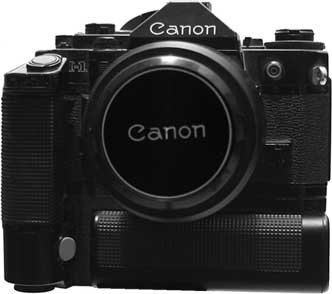
Lens Mount: FD bayonet/breech
Format: 35mm film
Battery: one PX28 or equivalent
Approx. dates of manufacture: 1978-1987
Approx. original price: $400
Approx. street value: Moderate
I was so happy when I finally got this camera. My first real camera, a Canon AE-1, put me squarely into the A-series cameras. As I read up on what the different models could do, I began drooling over the A-1's abilities. By modern standards it's no big deal, but at that time it was incredible: Shutter priority, aperture priority, full auto, full manual, stop-down metering, and intelligent flash exposure. All the FD lenses, plus the Motor Drive MA, which pulled around 5 frames-per-second (burning a 36-exposure roll in 7 seconds). Plus you could get other viewfinder screens for it, though you had to send it to the shop to have them installed. But still. Wow.
.jpg) The thing I liked most, and still do, was the in-viewfinder LED readout for both the aperture and shutter speed. Up until auto-focus came in, the history of
35mm SLRs from the 60s to the late 80s was all about the light meter. The earliest ones had no meter at all: you either guessed or you used a
hand-held meter. Later on meters were added but weren't connected to anything, and the pointer might be on the top of the camera, so you had to
take your eye from the viewfinder and look at the needle to set the camera. Then they began putting the needle in the the viewfinder.
The thing I liked most, and still do, was the in-viewfinder LED readout for both the aperture and shutter speed. Up until auto-focus came in, the history of
35mm SLRs from the 60s to the late 80s was all about the light meter. The earliest ones had no meter at all: you either guessed or you used a
hand-held meter. Later on meters were added but weren't connected to anything, and the pointer might be on the top of the camera, so you had to
take your eye from the viewfinder and look at the needle to set the camera. Then they began putting the needle in the the viewfinder.
Around the early 70s the good cameras had match-needle, where you had one needle you controlled (the shutter speed, if the camera was shutter-priority, or the aperture, if it was aperture priority) and a live needle that bounced around. You'd turn your control until the needles more-or-less matched up, and there was your exposure. But you still had to take your eyes off the viewfinder to look at your settings, or you had to look first and then keep them in your head as your switched things around.
Finally the camera companies began putting the numbers in the camera, but usually only one scale. The AE-1, for instance, only had the aperture scale visible inside; you still had to look at the shutter wheel if you wanted to know where you were. But the A-1 had both numbers in the viewfinder! No more taking your eyes off the viewfinder to see what your exposure settings were.
Because it was 70s design and materials, and was dependent on a lot of metal, it's a little bigger and heavier than the AE-1 and a lot bigger and heavier than modern cameras. Every so often I like to fit it with the motor drive, the Databack A, the 577G potato-masher flash, and my 100-300mm zoom, and call it robocamera; it is an impressive sight.
For more information: Canon Camera Museum
Modern Photography magazine camera test: July 1978
Modern Photography magazine "SLR Notebook" camera preview: May 1978
One of Modern Photography magazine's Top Cameras
Camera manual: Orphan Cameras.com



